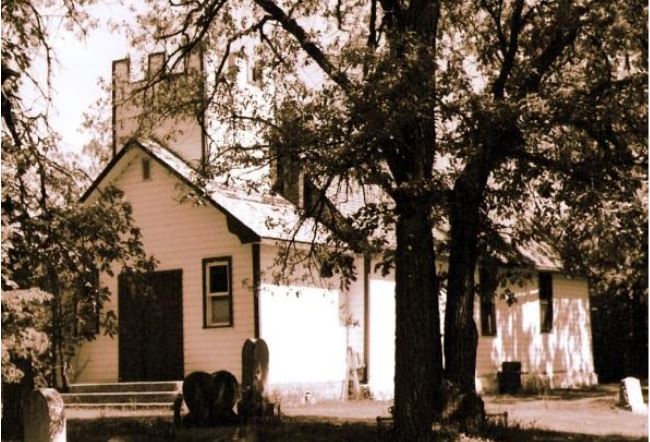As an Anglican congregation in a thinly populated, non-Anglican area, the experience of St. Jude’s was different from that of most Anglican Churches in the province.
St. Jude’s Anglican Church is located on the corner of Sunset Avenue and Grey Avenue in the community of Grand Marais. The first landowners of Grand Marais, Gilbert and Harriet Denett, are buried in the churchyard.
George Rupert and Alex Knott donated the land for the church and cemetery in the latter part of the 1890s. Alex Knott’s mother, Grandma Marie Knott, was the first person buried in the cemetery. The church was constructed in 1896 from hand-sawn black poplar logs. Five men built the church with their own volunteer labour. Jim Raven from Scanterbury made the first hand-sawn pews, holy table and shelf. He successfully completed the woodworking tasks with only one arm.

The bell within the tower was salvaged from the first fire hall in Winnipeg. Canon George Smith of St. Peter’s helped raise the money to buy the first organ in 1914 by holding basket and pie socials. In 1931, a chancel sanctuary and two vestry rooms were added. The Easter service on April 6, 1957 had a congregation of 112 people and the collection totaled $25.26.
The congregation moved to the new St. Jude’s Church in 1963. In 1970 the original church was made into a museum to celebrate Manitoba’s Centennial. It was open for three years and then only opened upon request. Today, the museum no longer exists; however, the church remains as one of the oldest and most cherished structures in Grand Marais.
An Early Church of St. Clements
The St. Jude’s geocache site is located in Grand Marais, Manitoba, Canada at N 50° 32.472 latitude and W 096° 37.365 longitude. If you find the geocache and scan the QR code inside of it, it brings you here to learn more. Watch all of our videos on our YouTube Channel. Other heritage content can be found on our Red River North Heritage Youtube channel.
Transcription:
The influx of immigrants to Manitoba in the 1890s sparked growth in the lakeside settlements of the east beaches. Fishing and lumbering businesses helped to establish the communities and attract new residents.
Out of these changes came the need for a local Anglican church. St. Jude’s became unusual as a Protestant church in a predominantly Métis community.
Despite growth, Grand Marais was still a small community on the edges of settlement in the province. St. Jude’s, likewise, was a backcountry church. Dozens of ministers circulated through to serve the congregation over the years, few of them staying long.
Reverend G. E. Sage’s ten years at the church between 1932 and 1942 was an impressive stint.
Some church members came to Grand Marais as part of ministry in the wider area. Captain W. A. Knight of the church army was posted to Scanterbury. From 1948 to 1952, he walked, biked, rode, mushed, or drove down to Grand Marais to conduct services.
Captain David Holmes served in Grand Marais, Balsam Bay, Scanterbury, and Victoria Beach from 1960 to 1963. The last regular minister at St. Jude’s was Reverend Robert H. Marsh, who began in 1969.
After him, Winnipeg and Selkirk supplied clergymen to drive out for services. Today, there is interest in the building itself for its intriguing architectural features and for its historical role in the area.